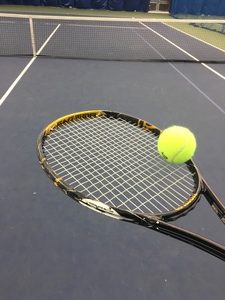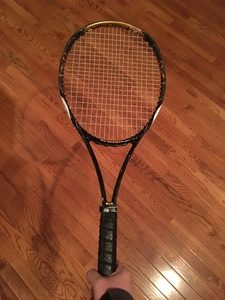Hey! This site is reader-supported and we earn commissions if you purchase products from retailers after clicking on a link from our site.
One of my first tennis racquets as I started the move from intermediate to advanced player and still one of my favorites today, the Wilson Blade 98 is meant for those aggressive and high energy players on the court.
| IMAGE | PRODUCT | Overall | ||
|---|---|---|---|---|
Top Pick |
Wilson Blade 98 v7 Tennis Racquet | Weighing in at 11.4 oz, the Wilson Blade 98 v7 certainly packs a punch. This new version features improved feel and control | Check Price |
Just to give you some background, I started playing with the Wilson Blade 98 as a teenager around age 16. I used this racket all throughout Varsity Tennis in high school and through my first 2 years playing college tennis.
Since then, Wilson has gone through multiple iterations of the Wilson Blade tennis racquet. The current version as of December 2019 is the Wilson Blade v7. From 2016 to 2019, the Wilson Blade used Countervail material. In this article, we’ll go review the Wilson Blade v7, the Wilson Blade Countervail, and even older versions of the racquet!
When I played with the Wilson Blade, I absolutely loved hitting big shots right at the limit of my power. And on their website, it seems like I was the exact customer Wilson was envisioning wielding the Wilson Blade.

In this article, we’ll go through exactly what makes this tennis racquet so great and which version you should get.
Wilson Blade v7 Racket Review
In it’s 7th iteration, the Wilson Blade has made a staggering change and decided not to incorporate the traditional Countervail Material.

While it still retains the streamlined green design, this Blade v7 is also visually different as you can see from the image above.
Rather than Countervail, Wilson decided to go with FeelFlex technology. What does that mean? Carbon elements are integrated around the frame of the Wilson Blade v7 in order to improve overall stability and flexibility.
There is also a slight change to the grip. Wilson added a slight “Top Grip Taper” to the handle. This helps hand positioning for players with two handed backhands.

On the court, I loved this racquet. The increased flexibility from the lack of Countervail material made itself immediately known. While warming up, I could feel the tennis ball sitting on the strings a little longer than it had in previous versions.
This gave the racquet a softer feel. I also immediately liked the choice of open string pattern (16×19). The Wilson Blade Countervail was primarily available in a closed pattern (18×20) which is great for power but not ideal for spin.
With the Wilson Blade v7, I was able to feel the tennis ball hit the stringbed and brush up the side of the ball in order to apply massive amounts of topspin – putting my opponents off balance.
The Wilson Blade v7 features the characteristic power of the Wilson Blade series but is definitely more control oriented than previous versions. If you had any problems with control with the past versions, this racquet is definitely worth a try.
Wilson Blade Countervail Review
Wilson constructed the frame of the Wilson Blade 98 out of braided graphite and basalt which are both lightweight yet strong materials. By using a combination of two materials, the Blade 98 can flex slightly more which increases the contact area between the ball and the strings.
The Countervail name refers to the strands of carbon fiber woven into the frame of this tennis racquet. Wilson designed it in order to dampen shocks to the arm and reduce muscle fatigue during play without affecting the feel.
While the Wilson Blade CV is very comfortable and does not transmit much vibrations (making it good for players who have tennis elbow), on the court you’ll experience a slightly muted feel when hitting the ball.
The Wilson Blade CV also features parallel drilling which claims to provide a more consistent response from the string bed while also increasing the sweet spot.
It does this by drilling the grommet holes such that they are parallel to each other(hence the name parallel drilling). This method results in additional string movement which increases the size of the sweet spot.
The Wilson Blade 98 also incorporates Wilson’s Amplifeel technology which reduces vibrations throughout the frame in order to enhance player feel and comfort. This vibration dampening technology specifically helps people who suffer from joint pain and tennis elbow.
Wilson Blade Countervail vs Wilson Blade v7
So, what are the differences between the Wilson Blade Countervail and the Wilson Blade v7?
Both racquets feature a passion for power and are designed for aggressive players who like to put more power into every shot.
If we look at the technical specs of both racquets, we can see some minor differences.
| Wilson Blade V7 | Wilson Blade Countervail | |
| Weight | 11.4 | 11.3 |
| Balance | 4 pts HL | 3 pts HL |
| Flex Rating | 62 | 66 |
| Swing Weight | 328 | 326 |

On the court, you can feel the slight differences in specifications. The Wilson V7 is more flexible, more comfortable, and provides better feel of the tennis ball than the Wilson Blade Countervail.
A big complaint of the Wilson Blade CV is that it provided a muted feel of the ball while playing. With the Wilson Blade v7, you’ll be able to feel the tennis ball against the strings and effortlessly apply spin.
The increased flexibility does not come at a cost though. Compared to the Wilson Blade Countervail, the Blade V7 does have slightly reduced power. On the court, you’ll have to swing through the ball a little more.
If you have a two handed backhand, you’ll notice a difference between the two immediately. The Wilson Blade V7 has a slightly longer handle making it more comfortable for players who have a two handed backhand.
Older Versions of the Wilson Blade

Holding this racket as you walk onto the court, you can feel the slight heft of the racket in your hand. It’s by no means heavy though coming it at a weight of 11.3 ounces.
Actually, I as started warming up to play a game, I started warming up to the weight of the racquet also. It’s heavy enough to remind you that you’re swinging a racket yet light enough to play with for long hours.
The weight of the Wilson Blade also has another advantage in that it allows you to put some power behind your shots.
Wilson specifically targeted this racket towards aggressive players who like to hit big shots and the weight of this racket certainly allows for it.
As I started getting into a rhythm with my strokes and rallies with my partner, I specifically took breaks just to write down how this racket felt. One of the things that I especially liked was the pop off of the string bed of the racket.
I would make contact with the ball and instantly feel a slight response as I swung through it. Looking over the frame construction, this pop and most of the power in this racket is due to the layup of graphite-basalt within the frame.

I also liked how Wilson improved the response to off center hits in this version of the Blade 98. In earlier versions, your racket would almost twist out of your hands if you hit it off center.
In the latest version(2019), the Wilson Blade 98 is much more forgiving to hits outside of the sweetspot.
Going from my previous racquet to the Blade 98, made my serve one of my biggest advantages in my competitive games. The Blade 98 took my first serves and amplified all of the power behind them while still providing me with enough control in order to make sure they stayed in.
For people who like to hit flat and powerful serves, the Blade 98 will serve you well.
One area where the most recent Wilson Blade 98 falls a little short on the court, is with regards to spin. And, being completely honest, this is mainly a function of the string pattern and not the racket itself.
The most recent Wilson Blade 98 is strung with a 18×20 pattern or a traditional “closed pattern”.
While this does give you terrific control over where you hit the ball, it makes it slightly harder for players to apply lots of spin to the ball.
The good news here is that you can easily grab a slightly older version of the racket(which is strung in a 16 x 19 pattern) which will give you that spin capability back.
Who should buy the Wilson Blade 98?
Wilson designed this tennis racquet for the aggressive player who likes to put a lot(maybe too much) power into his or her shots.
The Wilson Blade 98 provides the perfect mix of power and control for this player in order to help them quickly take their game to the next level.
See Additional Reviews, Pictures, and More Information about the Wilson Blade 98 Here!
In terms of level, most players from intermediate to advanced would get an immediate benefit in their game from using the Wilson Blade 98. Again, it’s one of my favorite racquets and it excels at it’s purpose.
If you are looking for a little bit more control in order to reign in your power, the Wilson Blade 98 tennis racket is for you.
Leave a Reply